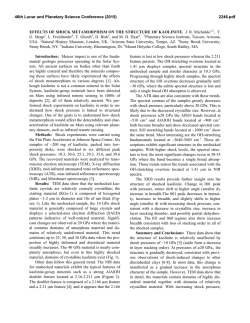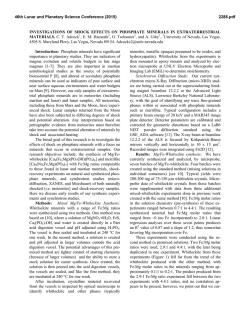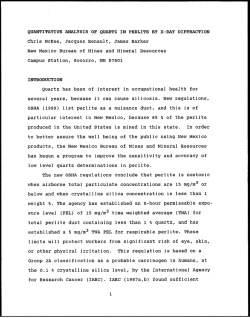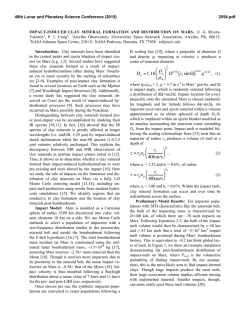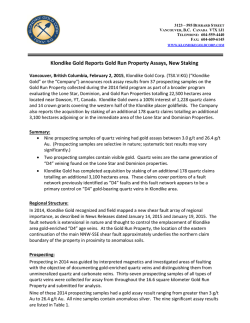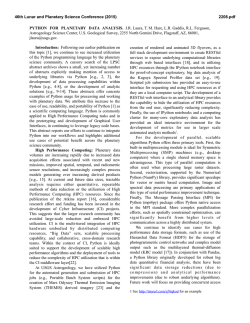
PRESERVATION OF DETRITAL SHOCKED MINERALS IN DEEP
46th Lunar and Planetary Science Conference (2015) 1629.pdf PRESERVATION OF DETRITAL SHOCKED MINERALS IN DEEP TIME: SHOCKED GRAINS IN THE 300 Myr DWYKA GROUP TILLITE, SOUTH AFRICA M. R. Pincus1, A. J. Cavosie1,2, and R. Gibbon3 1Univ. Puerto Rico-Mayagüez, 2Curtin Univ, 3Univ. New Brunswick. Introduction: While it has long been known that shocked minerals are preserved in target rocks [eg. 1], recent investigations have demonstrated that shock microstructures in minerals such as zircon, monazite, and quartz also survive erosion of the impact structure and transportation by fluvial and glacio-fluvial processes [2-4]. Shocked minerals have been found in modern sands and sedimentary rocks eroded from four impact structures: the Vredefort Dome, South Africa [2,3,5]; Sudbury, Ontario, Canada [4]; Rock Elm, Wisconsin, USA [6,7]; and Santa Fe, New Mexico, USA [8-11]. These detrital shocked minerals have been found locally, near and within their source impact structures [2,4,6-11], as well as hundreds of kilometers downriver [3,5]. Here we report detrital shocked minerals in the lithified 300 Ma Dwyka Group tillite, eroded from the Vredefort Dome impact structure. These results not only contribute to Vredefort's detrital shocked mineral story, but also add to Earth's impact record by demonstrating that shocked minerals can endure lithification and preservation through deep time. Detrital shocked minerals in Dwyka tillite: A total of ten poorly-indurated tillite samples were collected from the core and collar of the Vredefort Dome impact structure (Fig. 1). Grain exteriors of 100 zircons from nine of these samples were analyzed using back scattered electron (BSE) imaging. All samples contained impact-shocked zircons (Fig. 2), ranging from 27% in a sand-poor tillite from the collar of the impact structure, to 63% in a sand-rich tillite from the core (average = 41%). Twenty-one monazite grains from the core tillite sample were also analyzed by BSE imaging. 100% of these grains show evidence of shock, with up to three orientations of planar microstructures preserved (Fig. 3). Thin sections of each of the ten samples were surveyed for shocked quartz using petrographical methods. All samples contain shocked quartz, exhibited by grains with up to two orientations of decorated planar deformation features (PDFs) (Fig. 4a). Less frequently, quartz grains contained feather features (Fig. 4b,c), another shock microstructure found in quartz, associated with planar fractures. One well-lithified diamictite sample was collected ~40km from the center of the Vredefort Dome, outside the modern exposure of the impact structure (Fig. 1). One hundred zircons separated from the diamictite were surveyed for surface expressions of shock microstructures using BSE imaging, yielding nine shocked zircons. Thin sections made from this sample yielded two quartzite clasts that contained shocked quartz. These samples were collected from outside the known limit of PDFs in quartz [12]. Figure 1. Simplified geological map of the Vredefort Dome impact structure, South Africa, with sample locations. Modified from [12]. a. b. Figure 2. BSE images of Vredefort-derived shocked zircons from the 300 Ma Dwyka Group tillite, 46th Lunar and Planetary Science Conference (2015) exhibiting four (a) and three (b) orientations of planar fractures. a. 1629.pdf Erickson T.M. et al. (2013) GCA, 107, 170-188. [4] Thomson O.A. et al. (2014) GSA Bulletin, 126, 720737. [5] Montalvo S.D. and Cavosie A.J. (2014) GSA. [6] Roig C. et al. (2013) LPSC. [7] Cavosie A.J. et al. (2013) LPSC. [8] Cavosie A.J. and Lugo C. (2014) LPSC. [9] Colón D. and Cavosie A.J. (2014) LPSC. [10] Lugo C. and Cavosie A.J. (2014) LPSC. [11] Montalvo P. and Cavosie (2014) GSA. [12] Gibson R. et al. (2002) JMG, 20, 57-70. a. b. b. Figure 3. BSE images of detrital shocked monazite from a sample of Dwyka tillite collected from the core of the Vredefort impact structure. Both grains exhibit three orientations of planar microstructures. Discussion: Detrital shocked minerals have been documented in lithified glacial tillites from the 300 Ma Dwyka Group in South Africa. These zircon, monazite, and quartz grains were eroded from the Vredefort Dome impact structure and transported by Permo-Carboniferous glaciers, where they were deposited, lithified, and preserved until present day. These findings demonstrate two new scenarios for preservation of shocked minerals: (1) that shock microstructures can withstand glacial transit, and (2) that shocked minerals can survive lithification and deep time in the rock record. These ancient preserved grains can be an important tool for a better understanding of Earth's early impact history. Though very few impact structures survive alteration, erosion, and burial from Earth's surface and tectonic processes, shocked minerals eroded from these impact structures can endure in the rock record. Sediments and sedimentary rocks containing shocked minerals can be the key to discovering the existence of ancient impacts that have long since been erased. References: [1] French B. (1998). [2] Cavosie A.J. et al. (2010) GSA Bulletin, 122, 1968-1980. [3] c. Figure 4. Photomicrographs of Vredefort-derived shocked quartz (PPL) exhibiting decorated PDFs (a) and PFs associated with feather features (b,c). (c) is a zoomed in view of the boxed area in (b).
© Copyright 2025
